BO1BLAW204 Business Law Case Study: Analyzing Negligence Claim
VerifiedAdded on 2023/06/07
|7
|2264
|195
Case Study
AI Summary
This case study examines a negligence claim involving Susan, Cliff, and Mary, focusing on the liability of Susan for damages caused by her dog, Benji. The analysis applies key legal principles such as duty of care, breach of duty, causation, and remoteness, referencing relevant case law including Donoghue v Stevenson and Caparo Industries Ltd v Dickman. The study evaluates whether Susan owed a duty of care to her neighbors, whether that duty was breached, and whether the damages suffered were a direct result of her actions or were too remote. It concludes that while Susan owed a duty of care, she did not breach it, and the damages were too remote due to the intervening actions of Kim, Cliff and Mary's daughter, thus Susan cannot be held liable for negligence. The study finds that defenses such as contributory negligence and voluntary assumption of risk do not apply, and the damages were not foreseeable. The document is available on Desklib, a platform that provides students with access to a variety of study tools including past papers and solved assignments.
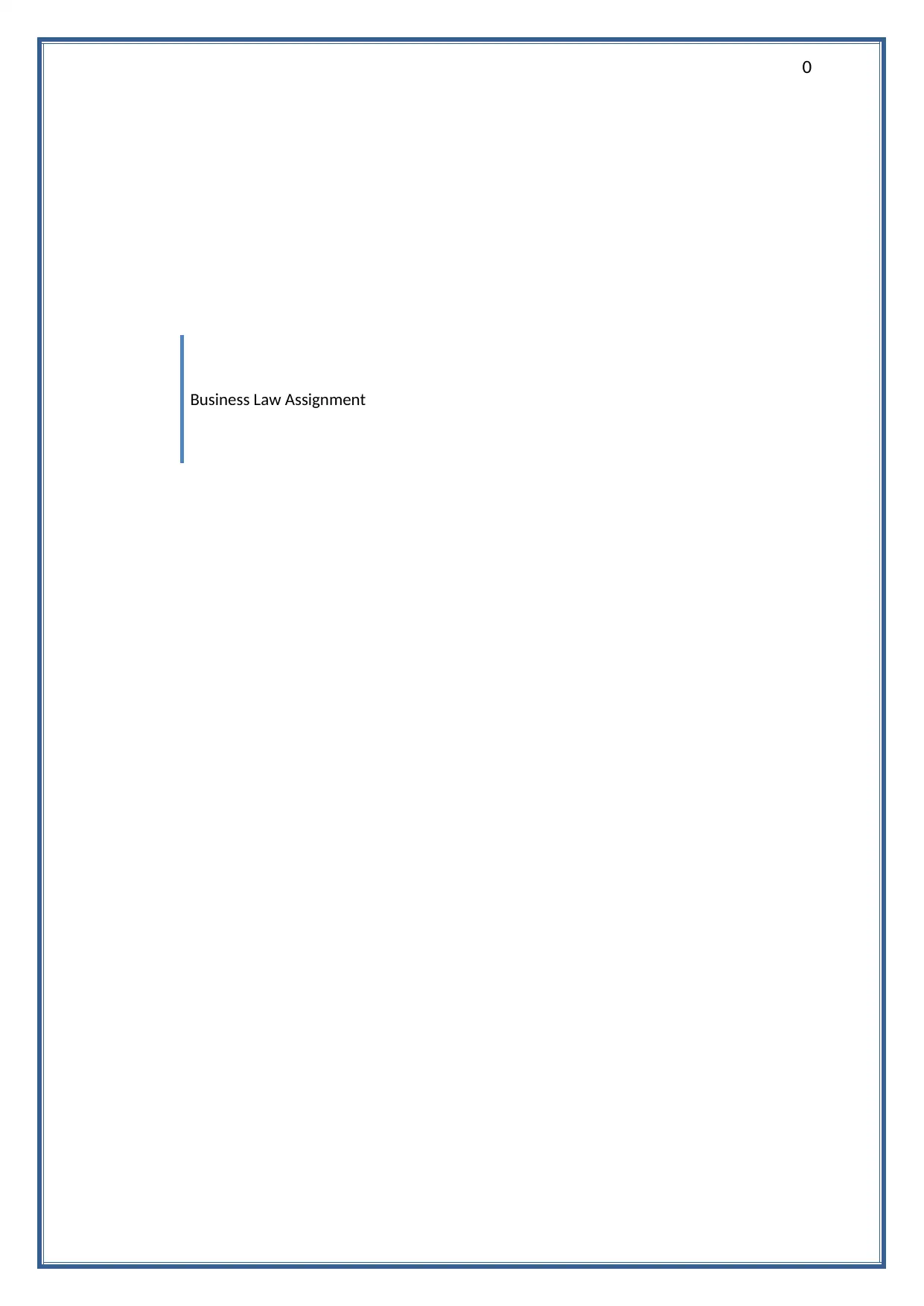
0
Business Law Assignment
Business Law Assignment
Paraphrase This Document
Need a fresh take? Get an instant paraphrase of this document with our AI Paraphraser
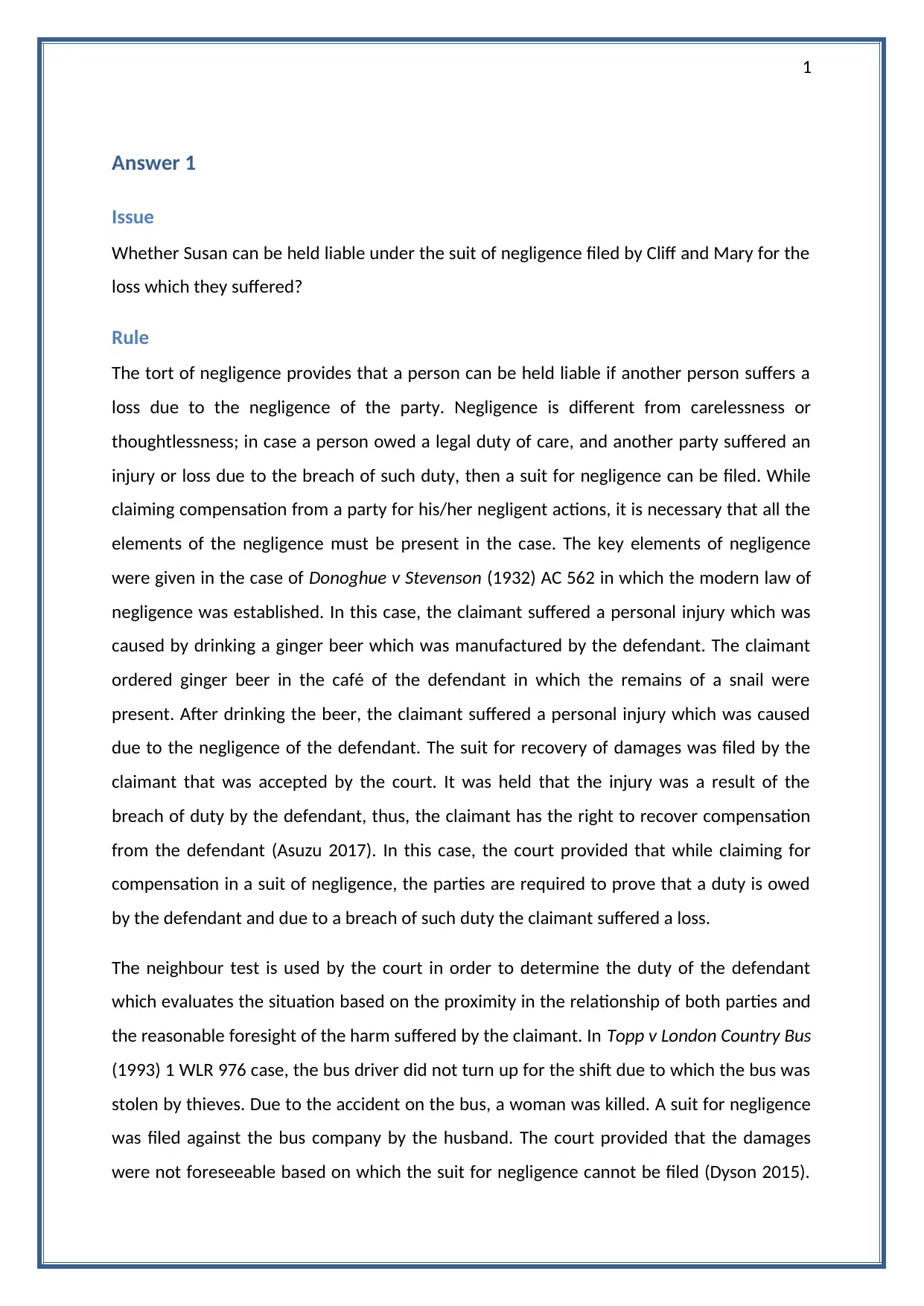
1
Answer 1
Issue
Whether Susan can be held liable under the suit of negligence filed by Cliff and Mary for the
loss which they suffered?
Rule
The tort of negligence provides that a person can be held liable if another person suffers a
loss due to the negligence of the party. Negligence is different from carelessness or
thoughtlessness; in case a person owed a legal duty of care, and another party suffered an
injury or loss due to the breach of such duty, then a suit for negligence can be filed. While
claiming compensation from a party for his/her negligent actions, it is necessary that all the
elements of the negligence must be present in the case. The key elements of negligence
were given in the case of Donoghue v Stevenson (1932) AC 562 in which the modern law of
negligence was established. In this case, the claimant suffered a personal injury which was
caused by drinking a ginger beer which was manufactured by the defendant. The claimant
ordered ginger beer in the café of the defendant in which the remains of a snail were
present. After drinking the beer, the claimant suffered a personal injury which was caused
due to the negligence of the defendant. The suit for recovery of damages was filed by the
claimant that was accepted by the court. It was held that the injury was a result of the
breach of duty by the defendant, thus, the claimant has the right to recover compensation
from the defendant (Asuzu 2017). In this case, the court provided that while claiming for
compensation in a suit of negligence, the parties are required to prove that a duty is owed
by the defendant and due to a breach of such duty the claimant suffered a loss.
The neighbour test is used by the court in order to determine the duty of the defendant
which evaluates the situation based on the proximity in the relationship of both parties and
the reasonable foresight of the harm suffered by the claimant. In Topp v London Country Bus
(1993) 1 WLR 976 case, the bus driver did not turn up for the shift due to which the bus was
stolen by thieves. Due to the accident on the bus, a woman was killed. A suit for negligence
was filed against the bus company by the husband. The court provided that the damages
were not foreseeable based on which the suit for negligence cannot be filed (Dyson 2015).
Answer 1
Issue
Whether Susan can be held liable under the suit of negligence filed by Cliff and Mary for the
loss which they suffered?
Rule
The tort of negligence provides that a person can be held liable if another person suffers a
loss due to the negligence of the party. Negligence is different from carelessness or
thoughtlessness; in case a person owed a legal duty of care, and another party suffered an
injury or loss due to the breach of such duty, then a suit for negligence can be filed. While
claiming compensation from a party for his/her negligent actions, it is necessary that all the
elements of the negligence must be present in the case. The key elements of negligence
were given in the case of Donoghue v Stevenson (1932) AC 562 in which the modern law of
negligence was established. In this case, the claimant suffered a personal injury which was
caused by drinking a ginger beer which was manufactured by the defendant. The claimant
ordered ginger beer in the café of the defendant in which the remains of a snail were
present. After drinking the beer, the claimant suffered a personal injury which was caused
due to the negligence of the defendant. The suit for recovery of damages was filed by the
claimant that was accepted by the court. It was held that the injury was a result of the
breach of duty by the defendant, thus, the claimant has the right to recover compensation
from the defendant (Asuzu 2017). In this case, the court provided that while claiming for
compensation in a suit of negligence, the parties are required to prove that a duty is owed
by the defendant and due to a breach of such duty the claimant suffered a loss.
The neighbour test is used by the court in order to determine the duty of the defendant
which evaluates the situation based on the proximity in the relationship of both parties and
the reasonable foresight of the harm suffered by the claimant. In Topp v London Country Bus
(1993) 1 WLR 976 case, the bus driver did not turn up for the shift due to which the bus was
stolen by thieves. Due to the accident on the bus, a woman was killed. A suit for negligence
was filed against the bus company by the husband. The court provided that the damages
were not foreseeable based on which the suit for negligence cannot be filed (Dyson 2015).
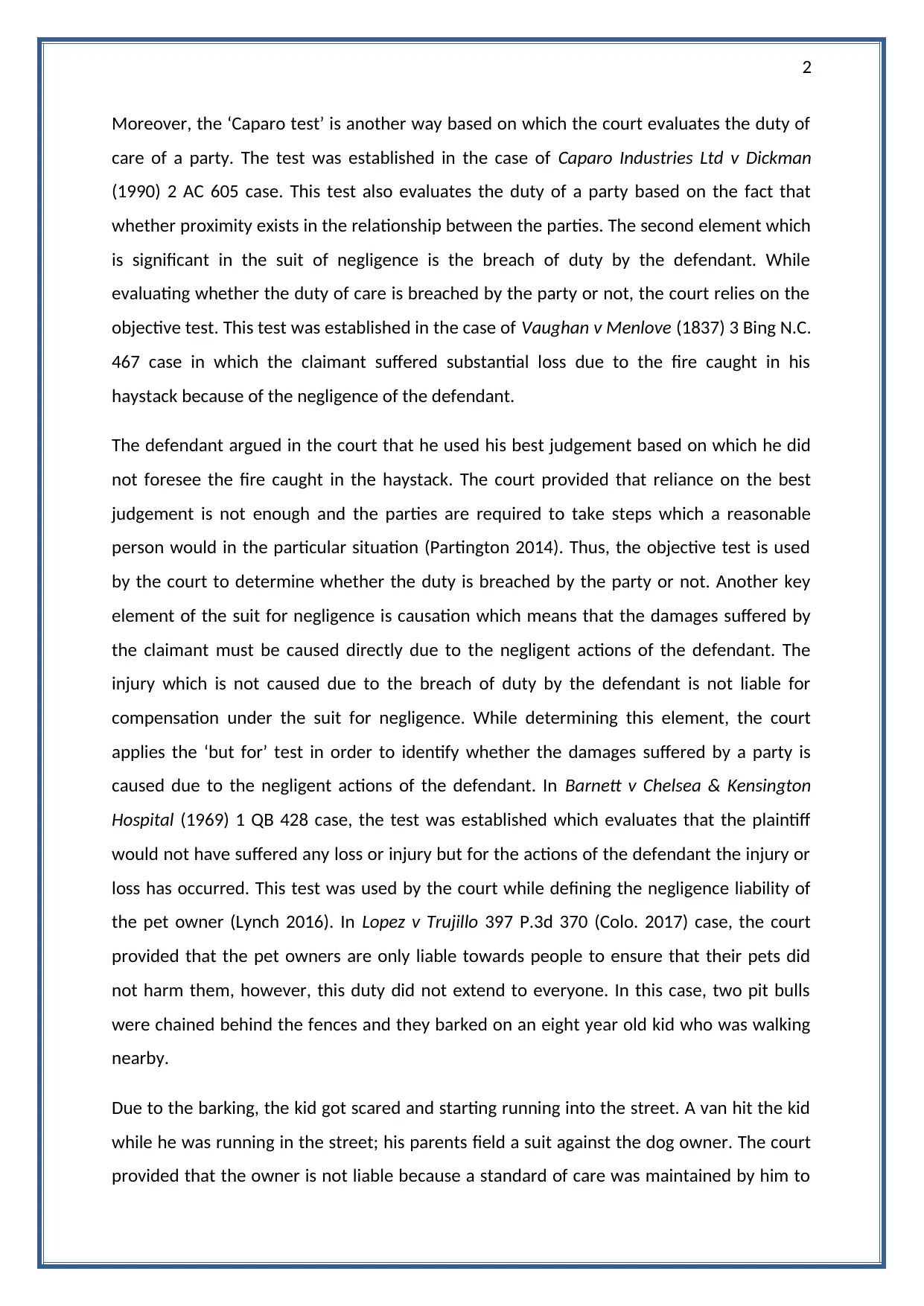
2
Moreover, the ‘Caparo test’ is another way based on which the court evaluates the duty of
care of a party. The test was established in the case of Caparo Industries Ltd v Dickman
(1990) 2 AC 605 case. This test also evaluates the duty of a party based on the fact that
whether proximity exists in the relationship between the parties. The second element which
is significant in the suit of negligence is the breach of duty by the defendant. While
evaluating whether the duty of care is breached by the party or not, the court relies on the
objective test. This test was established in the case of Vaughan v Menlove (1837) 3 Bing N.C.
467 case in which the claimant suffered substantial loss due to the fire caught in his
haystack because of the negligence of the defendant.
The defendant argued in the court that he used his best judgement based on which he did
not foresee the fire caught in the haystack. The court provided that reliance on the best
judgement is not enough and the parties are required to take steps which a reasonable
person would in the particular situation (Partington 2014). Thus, the objective test is used
by the court to determine whether the duty is breached by the party or not. Another key
element of the suit for negligence is causation which means that the damages suffered by
the claimant must be caused directly due to the negligent actions of the defendant. The
injury which is not caused due to the breach of duty by the defendant is not liable for
compensation under the suit for negligence. While determining this element, the court
applies the ‘but for’ test in order to identify whether the damages suffered by a party is
caused due to the negligent actions of the defendant. In Barnett v Chelsea & Kensington
Hospital (1969) 1 QB 428 case, the test was established which evaluates that the plaintiff
would not have suffered any loss or injury but for the actions of the defendant the injury or
loss has occurred. This test was used by the court while defining the negligence liability of
the pet owner (Lynch 2016). In Lopez v Trujillo 397 P.3d 370 (Colo. 2017) case, the court
provided that the pet owners are only liable towards people to ensure that their pets did
not harm them, however, this duty did not extend to everyone. In this case, two pit bulls
were chained behind the fences and they barked on an eight year old kid who was walking
nearby.
Due to the barking, the kid got scared and starting running into the street. A van hit the kid
while he was running in the street; his parents field a suit against the dog owner. The court
provided that the owner is not liable because a standard of care was maintained by him to
Moreover, the ‘Caparo test’ is another way based on which the court evaluates the duty of
care of a party. The test was established in the case of Caparo Industries Ltd v Dickman
(1990) 2 AC 605 case. This test also evaluates the duty of a party based on the fact that
whether proximity exists in the relationship between the parties. The second element which
is significant in the suit of negligence is the breach of duty by the defendant. While
evaluating whether the duty of care is breached by the party or not, the court relies on the
objective test. This test was established in the case of Vaughan v Menlove (1837) 3 Bing N.C.
467 case in which the claimant suffered substantial loss due to the fire caught in his
haystack because of the negligence of the defendant.
The defendant argued in the court that he used his best judgement based on which he did
not foresee the fire caught in the haystack. The court provided that reliance on the best
judgement is not enough and the parties are required to take steps which a reasonable
person would in the particular situation (Partington 2014). Thus, the objective test is used
by the court to determine whether the duty is breached by the party or not. Another key
element of the suit for negligence is causation which means that the damages suffered by
the claimant must be caused directly due to the negligent actions of the defendant. The
injury which is not caused due to the breach of duty by the defendant is not liable for
compensation under the suit for negligence. While determining this element, the court
applies the ‘but for’ test in order to identify whether the damages suffered by a party is
caused due to the negligent actions of the defendant. In Barnett v Chelsea & Kensington
Hospital (1969) 1 QB 428 case, the test was established which evaluates that the plaintiff
would not have suffered any loss or injury but for the actions of the defendant the injury or
loss has occurred. This test was used by the court while defining the negligence liability of
the pet owner (Lynch 2016). In Lopez v Trujillo 397 P.3d 370 (Colo. 2017) case, the court
provided that the pet owners are only liable towards people to ensure that their pets did
not harm them, however, this duty did not extend to everyone. In this case, two pit bulls
were chained behind the fences and they barked on an eight year old kid who was walking
nearby.
Due to the barking, the kid got scared and starting running into the street. A van hit the kid
while he was running in the street; his parents field a suit against the dog owner. The court
provided that the owner is not liable because a standard of care was maintained by him to
⊘ This is a preview!⊘
Do you want full access?
Subscribe today to unlock all pages.

Trusted by 1+ million students worldwide
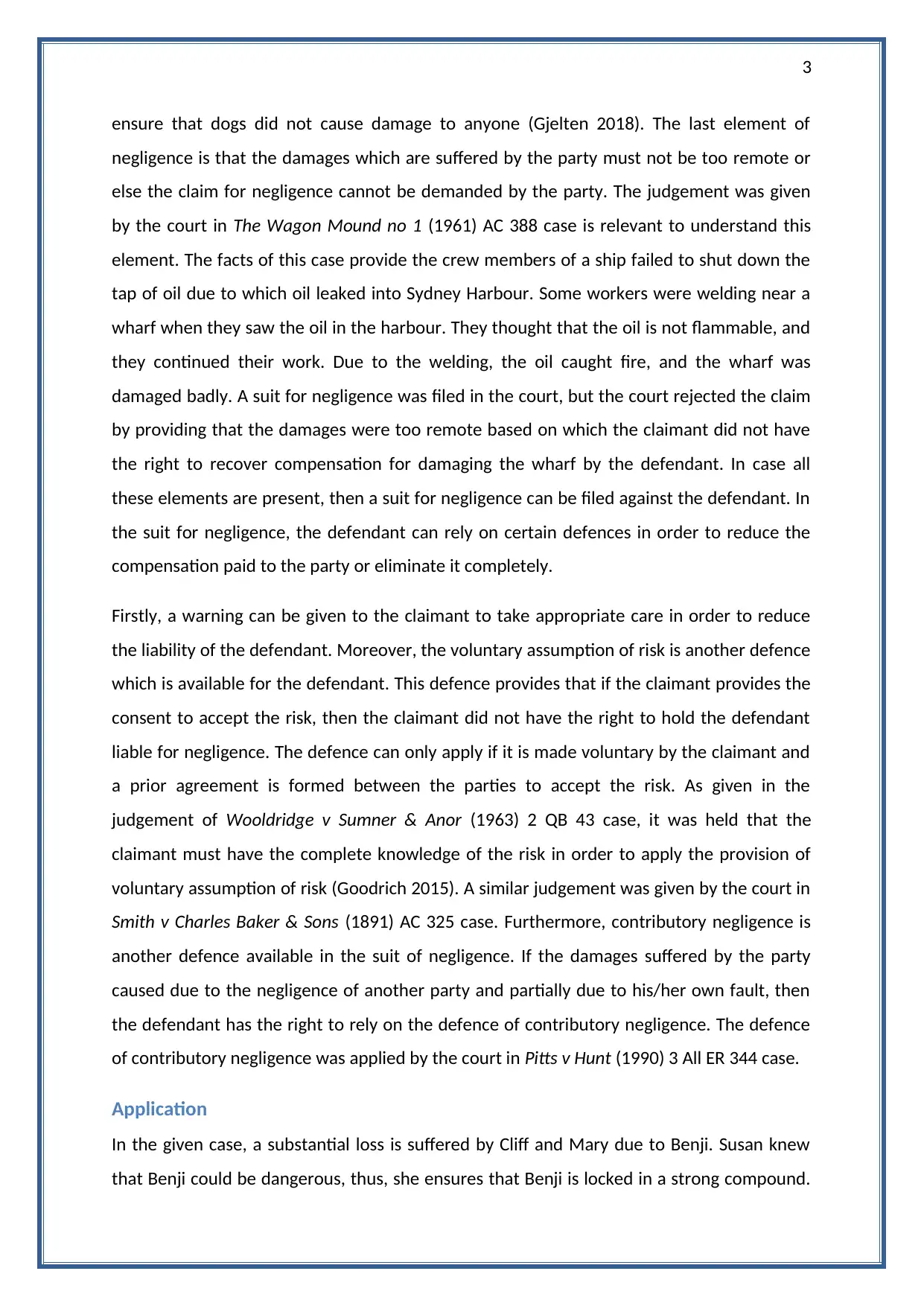
3
ensure that dogs did not cause damage to anyone (Gjelten 2018). The last element of
negligence is that the damages which are suffered by the party must not be too remote or
else the claim for negligence cannot be demanded by the party. The judgement was given
by the court in The Wagon Mound no 1 (1961) AC 388 case is relevant to understand this
element. The facts of this case provide the crew members of a ship failed to shut down the
tap of oil due to which oil leaked into Sydney Harbour. Some workers were welding near a
wharf when they saw the oil in the harbour. They thought that the oil is not flammable, and
they continued their work. Due to the welding, the oil caught fire, and the wharf was
damaged badly. A suit for negligence was filed in the court, but the court rejected the claim
by providing that the damages were too remote based on which the claimant did not have
the right to recover compensation for damaging the wharf by the defendant. In case all
these elements are present, then a suit for negligence can be filed against the defendant. In
the suit for negligence, the defendant can rely on certain defences in order to reduce the
compensation paid to the party or eliminate it completely.
Firstly, a warning can be given to the claimant to take appropriate care in order to reduce
the liability of the defendant. Moreover, the voluntary assumption of risk is another defence
which is available for the defendant. This defence provides that if the claimant provides the
consent to accept the risk, then the claimant did not have the right to hold the defendant
liable for negligence. The defence can only apply if it is made voluntary by the claimant and
a prior agreement is formed between the parties to accept the risk. As given in the
judgement of Wooldridge v Sumner & Anor (1963) 2 QB 43 case, it was held that the
claimant must have the complete knowledge of the risk in order to apply the provision of
voluntary assumption of risk (Goodrich 2015). A similar judgement was given by the court in
Smith v Charles Baker & Sons (1891) AC 325 case. Furthermore, contributory negligence is
another defence available in the suit of negligence. If the damages suffered by the party
caused due to the negligence of another party and partially due to his/her own fault, then
the defendant has the right to rely on the defence of contributory negligence. The defence
of contributory negligence was applied by the court in Pitts v Hunt (1990) 3 All ER 344 case.
Application
In the given case, a substantial loss is suffered by Cliff and Mary due to Benji. Susan knew
that Benji could be dangerous, thus, she ensures that Benji is locked in a strong compound.
ensure that dogs did not cause damage to anyone (Gjelten 2018). The last element of
negligence is that the damages which are suffered by the party must not be too remote or
else the claim for negligence cannot be demanded by the party. The judgement was given
by the court in The Wagon Mound no 1 (1961) AC 388 case is relevant to understand this
element. The facts of this case provide the crew members of a ship failed to shut down the
tap of oil due to which oil leaked into Sydney Harbour. Some workers were welding near a
wharf when they saw the oil in the harbour. They thought that the oil is not flammable, and
they continued their work. Due to the welding, the oil caught fire, and the wharf was
damaged badly. A suit for negligence was filed in the court, but the court rejected the claim
by providing that the damages were too remote based on which the claimant did not have
the right to recover compensation for damaging the wharf by the defendant. In case all
these elements are present, then a suit for negligence can be filed against the defendant. In
the suit for negligence, the defendant can rely on certain defences in order to reduce the
compensation paid to the party or eliminate it completely.
Firstly, a warning can be given to the claimant to take appropriate care in order to reduce
the liability of the defendant. Moreover, the voluntary assumption of risk is another defence
which is available for the defendant. This defence provides that if the claimant provides the
consent to accept the risk, then the claimant did not have the right to hold the defendant
liable for negligence. The defence can only apply if it is made voluntary by the claimant and
a prior agreement is formed between the parties to accept the risk. As given in the
judgement of Wooldridge v Sumner & Anor (1963) 2 QB 43 case, it was held that the
claimant must have the complete knowledge of the risk in order to apply the provision of
voluntary assumption of risk (Goodrich 2015). A similar judgement was given by the court in
Smith v Charles Baker & Sons (1891) AC 325 case. Furthermore, contributory negligence is
another defence available in the suit of negligence. If the damages suffered by the party
caused due to the negligence of another party and partially due to his/her own fault, then
the defendant has the right to rely on the defence of contributory negligence. The defence
of contributory negligence was applied by the court in Pitts v Hunt (1990) 3 All ER 344 case.
Application
In the given case, a substantial loss is suffered by Cliff and Mary due to Benji. Susan knew
that Benji could be dangerous, thus, she ensures that Benji is locked in a strong compound.
Paraphrase This Document
Need a fresh take? Get an instant paraphrase of this document with our AI Paraphraser
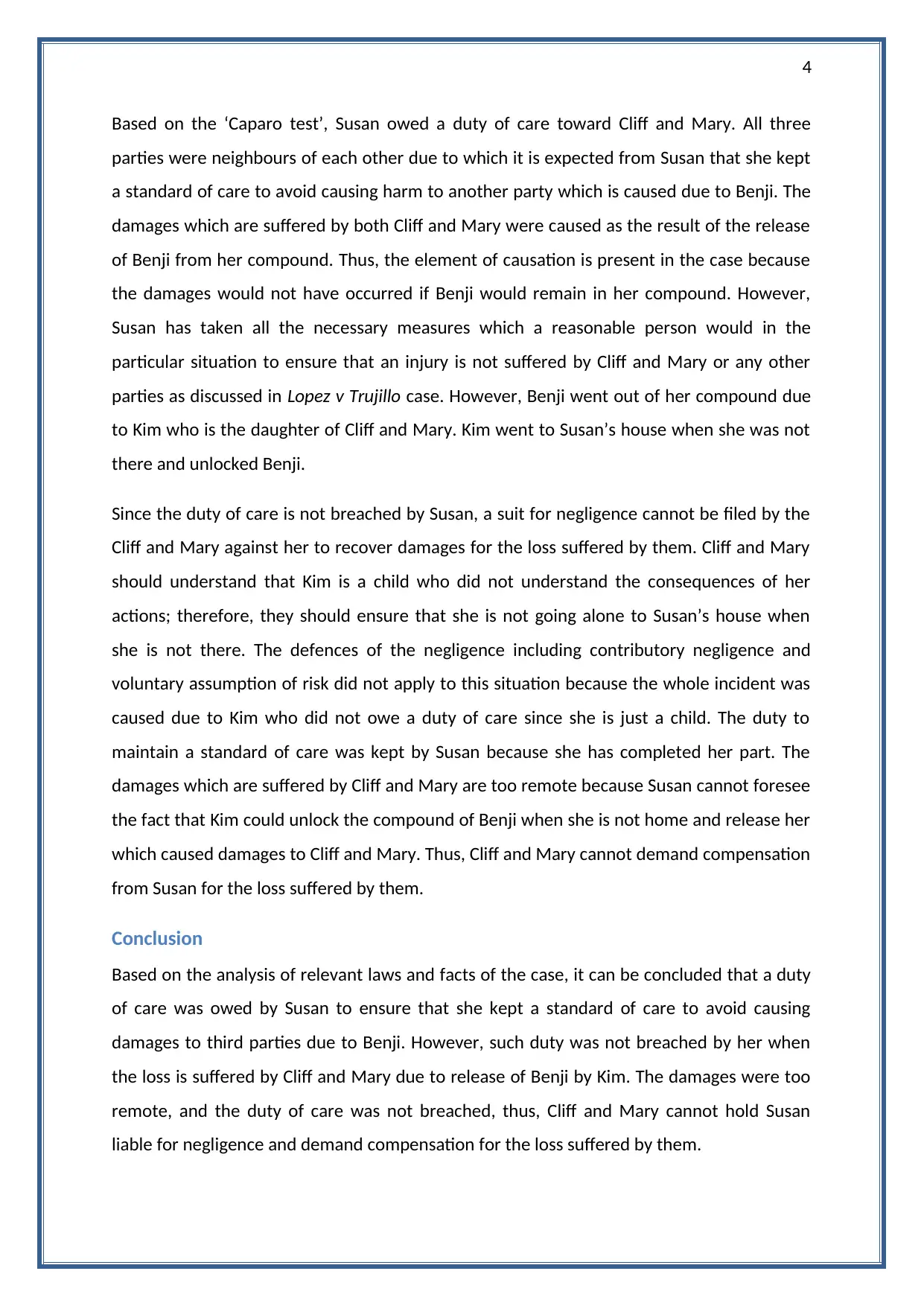
4
Based on the ‘Caparo test’, Susan owed a duty of care toward Cliff and Mary. All three
parties were neighbours of each other due to which it is expected from Susan that she kept
a standard of care to avoid causing harm to another party which is caused due to Benji. The
damages which are suffered by both Cliff and Mary were caused as the result of the release
of Benji from her compound. Thus, the element of causation is present in the case because
the damages would not have occurred if Benji would remain in her compound. However,
Susan has taken all the necessary measures which a reasonable person would in the
particular situation to ensure that an injury is not suffered by Cliff and Mary or any other
parties as discussed in Lopez v Trujillo case. However, Benji went out of her compound due
to Kim who is the daughter of Cliff and Mary. Kim went to Susan’s house when she was not
there and unlocked Benji.
Since the duty of care is not breached by Susan, a suit for negligence cannot be filed by the
Cliff and Mary against her to recover damages for the loss suffered by them. Cliff and Mary
should understand that Kim is a child who did not understand the consequences of her
actions; therefore, they should ensure that she is not going alone to Susan’s house when
she is not there. The defences of the negligence including contributory negligence and
voluntary assumption of risk did not apply to this situation because the whole incident was
caused due to Kim who did not owe a duty of care since she is just a child. The duty to
maintain a standard of care was kept by Susan because she has completed her part. The
damages which are suffered by Cliff and Mary are too remote because Susan cannot foresee
the fact that Kim could unlock the compound of Benji when she is not home and release her
which caused damages to Cliff and Mary. Thus, Cliff and Mary cannot demand compensation
from Susan for the loss suffered by them.
Conclusion
Based on the analysis of relevant laws and facts of the case, it can be concluded that a duty
of care was owed by Susan to ensure that she kept a standard of care to avoid causing
damages to third parties due to Benji. However, such duty was not breached by her when
the loss is suffered by Cliff and Mary due to release of Benji by Kim. The damages were too
remote, and the duty of care was not breached, thus, Cliff and Mary cannot hold Susan
liable for negligence and demand compensation for the loss suffered by them.
Based on the ‘Caparo test’, Susan owed a duty of care toward Cliff and Mary. All three
parties were neighbours of each other due to which it is expected from Susan that she kept
a standard of care to avoid causing harm to another party which is caused due to Benji. The
damages which are suffered by both Cliff and Mary were caused as the result of the release
of Benji from her compound. Thus, the element of causation is present in the case because
the damages would not have occurred if Benji would remain in her compound. However,
Susan has taken all the necessary measures which a reasonable person would in the
particular situation to ensure that an injury is not suffered by Cliff and Mary or any other
parties as discussed in Lopez v Trujillo case. However, Benji went out of her compound due
to Kim who is the daughter of Cliff and Mary. Kim went to Susan’s house when she was not
there and unlocked Benji.
Since the duty of care is not breached by Susan, a suit for negligence cannot be filed by the
Cliff and Mary against her to recover damages for the loss suffered by them. Cliff and Mary
should understand that Kim is a child who did not understand the consequences of her
actions; therefore, they should ensure that she is not going alone to Susan’s house when
she is not there. The defences of the negligence including contributory negligence and
voluntary assumption of risk did not apply to this situation because the whole incident was
caused due to Kim who did not owe a duty of care since she is just a child. The duty to
maintain a standard of care was kept by Susan because she has completed her part. The
damages which are suffered by Cliff and Mary are too remote because Susan cannot foresee
the fact that Kim could unlock the compound of Benji when she is not home and release her
which caused damages to Cliff and Mary. Thus, Cliff and Mary cannot demand compensation
from Susan for the loss suffered by them.
Conclusion
Based on the analysis of relevant laws and facts of the case, it can be concluded that a duty
of care was owed by Susan to ensure that she kept a standard of care to avoid causing
damages to third parties due to Benji. However, such duty was not breached by her when
the loss is suffered by Cliff and Mary due to release of Benji by Kim. The damages were too
remote, and the duty of care was not breached, thus, Cliff and Mary cannot hold Susan
liable for negligence and demand compensation for the loss suffered by them.
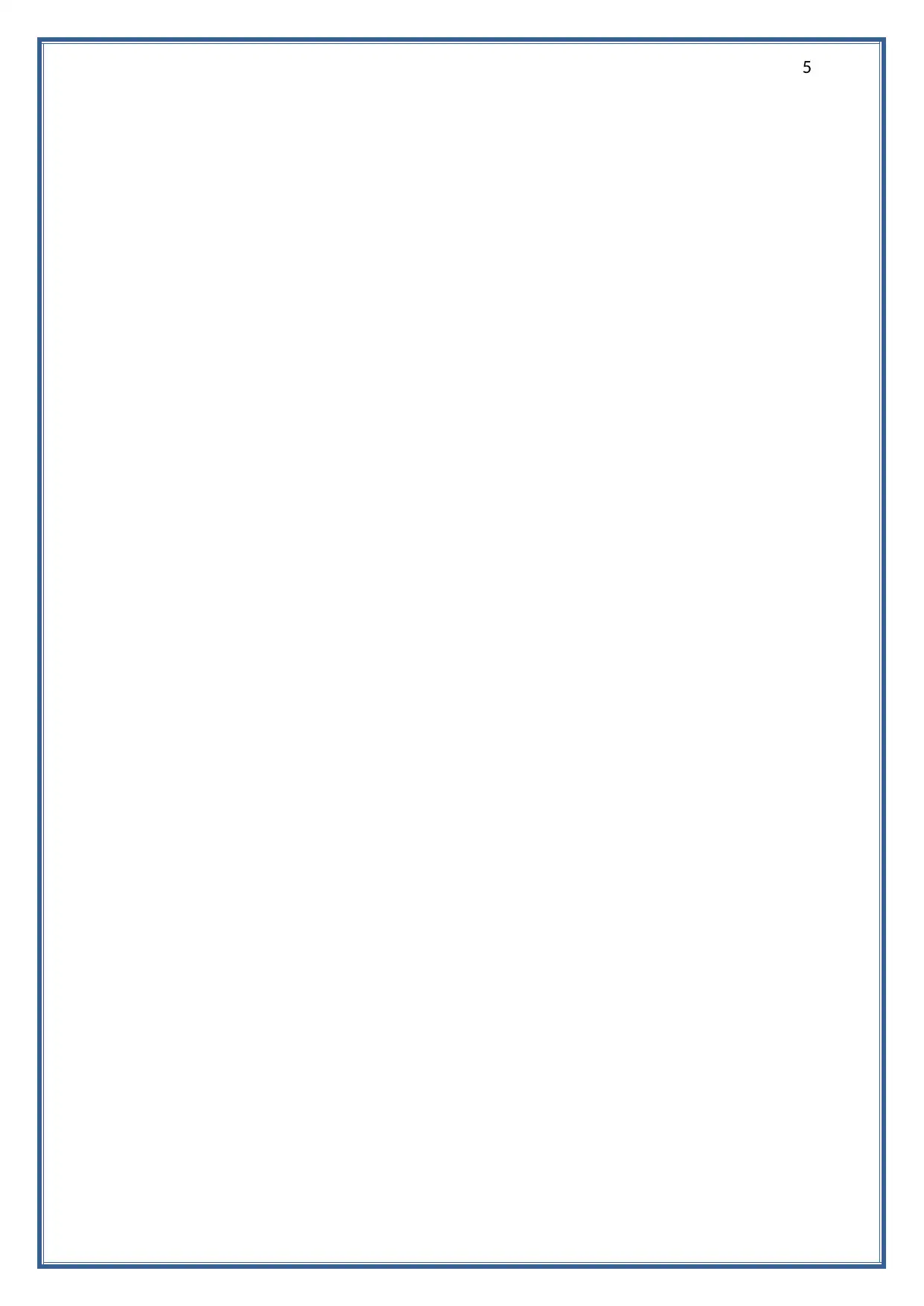
5
⊘ This is a preview!⊘
Do you want full access?
Subscribe today to unlock all pages.

Trusted by 1+ million students worldwide
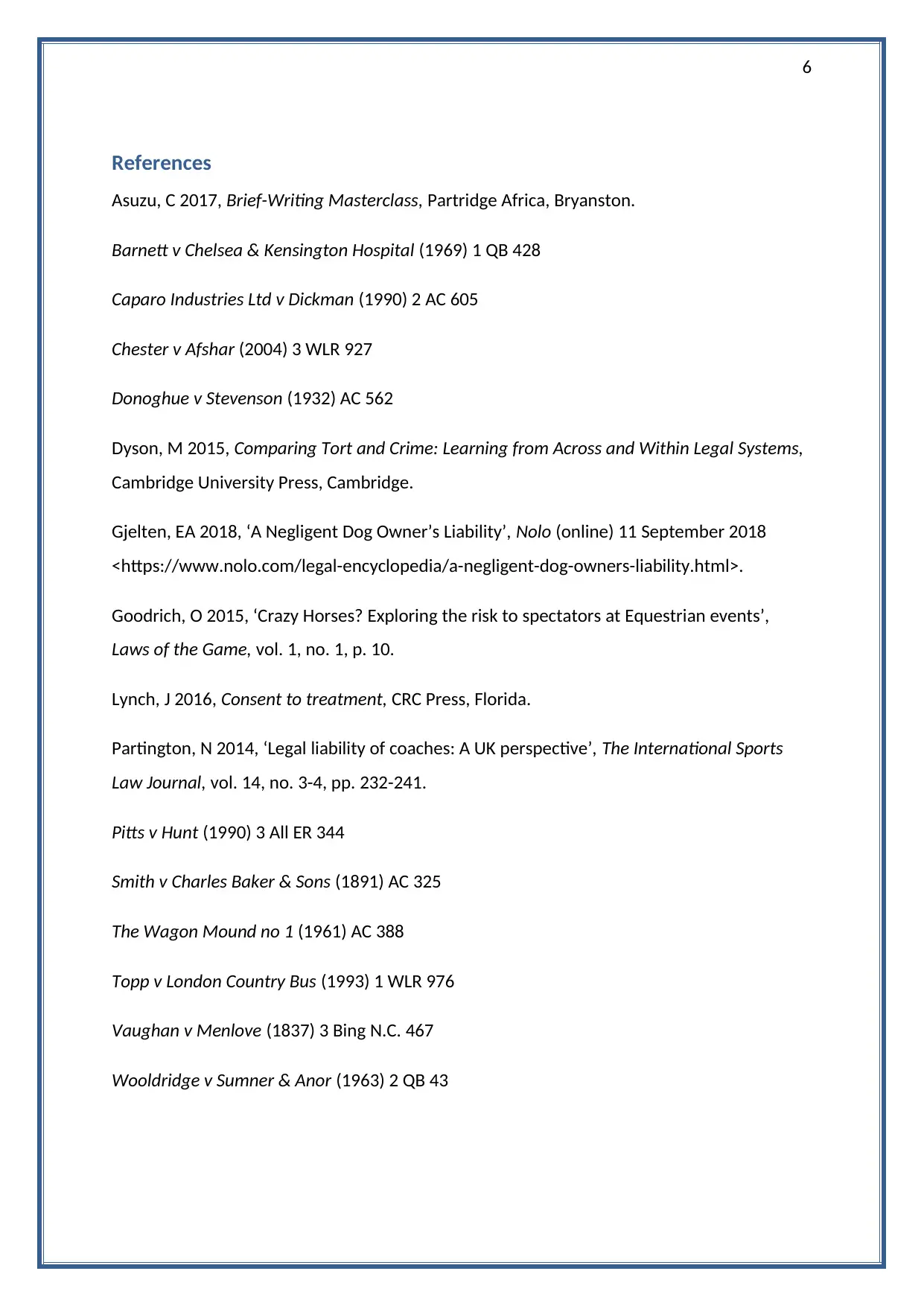
6
References
Asuzu, C 2017, Brief-Writing Masterclass, Partridge Africa, Bryanston.
Barnett v Chelsea & Kensington Hospital (1969) 1 QB 428
Caparo Industries Ltd v Dickman (1990) 2 AC 605
Chester v Afshar (2004) 3 WLR 927
Donoghue v Stevenson (1932) AC 562
Dyson, M 2015, Comparing Tort and Crime: Learning from Across and Within Legal Systems,
Cambridge University Press, Cambridge.
Gjelten, EA 2018, ‘A Negligent Dog Owner’s Liability’, Nolo (online) 11 September 2018
<https://www.nolo.com/legal-encyclopedia/a-negligent-dog-owners-liability.html>.
Goodrich, O 2015, ‘Crazy Horses? Exploring the risk to spectators at Equestrian events’,
Laws of the Game, vol. 1, no. 1, p. 10.
Lynch, J 2016, Consent to treatment, CRC Press, Florida.
Partington, N 2014, ‘Legal liability of coaches: A UK perspective’, The International Sports
Law Journal, vol. 14, no. 3-4, pp. 232-241.
Pitts v Hunt (1990) 3 All ER 344
Smith v Charles Baker & Sons (1891) AC 325
The Wagon Mound no 1 (1961) AC 388
Topp v London Country Bus (1993) 1 WLR 976
Vaughan v Menlove (1837) 3 Bing N.C. 467
Wooldridge v Sumner & Anor (1963) 2 QB 43
References
Asuzu, C 2017, Brief-Writing Masterclass, Partridge Africa, Bryanston.
Barnett v Chelsea & Kensington Hospital (1969) 1 QB 428
Caparo Industries Ltd v Dickman (1990) 2 AC 605
Chester v Afshar (2004) 3 WLR 927
Donoghue v Stevenson (1932) AC 562
Dyson, M 2015, Comparing Tort and Crime: Learning from Across and Within Legal Systems,
Cambridge University Press, Cambridge.
Gjelten, EA 2018, ‘A Negligent Dog Owner’s Liability’, Nolo (online) 11 September 2018
<https://www.nolo.com/legal-encyclopedia/a-negligent-dog-owners-liability.html>.
Goodrich, O 2015, ‘Crazy Horses? Exploring the risk to spectators at Equestrian events’,
Laws of the Game, vol. 1, no. 1, p. 10.
Lynch, J 2016, Consent to treatment, CRC Press, Florida.
Partington, N 2014, ‘Legal liability of coaches: A UK perspective’, The International Sports
Law Journal, vol. 14, no. 3-4, pp. 232-241.
Pitts v Hunt (1990) 3 All ER 344
Smith v Charles Baker & Sons (1891) AC 325
The Wagon Mound no 1 (1961) AC 388
Topp v London Country Bus (1993) 1 WLR 976
Vaughan v Menlove (1837) 3 Bing N.C. 467
Wooldridge v Sumner & Anor (1963) 2 QB 43
1 out of 7
Related Documents
Your All-in-One AI-Powered Toolkit for Academic Success.
+13062052269
info@desklib.com
Available 24*7 on WhatsApp / Email
![[object Object]](/_next/static/media/star-bottom.7253800d.svg)
Unlock your academic potential
Copyright © 2020–2025 A2Z Services. All Rights Reserved. Developed and managed by ZUCOL.




